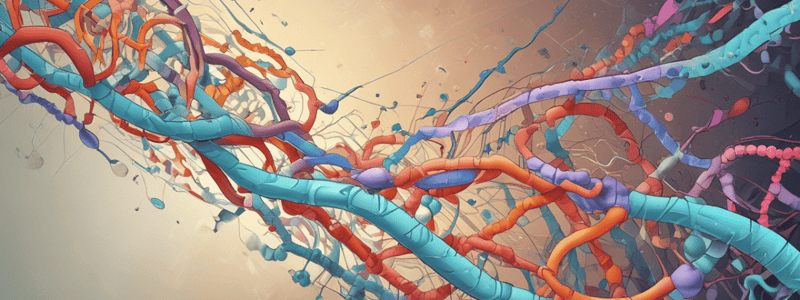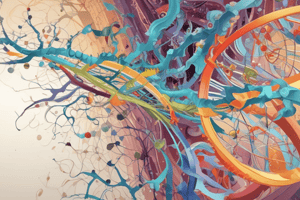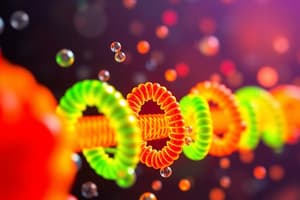Podcast
Questions and Answers
What is the primary limitation of using the Sanger Reagent method to determine the sequence of a polypeptide?
What is the primary limitation of using the Sanger Reagent method to determine the sequence of a polypeptide?
- It destroys the rest of the polypeptide chain (correct)
- It is unable to label the first amino acid
- It requires a large amount of the polypeptide
- It is only applicable to simple polypeptide chains
What is the purpose of using a basic condition in the Sanger Reagent method?
What is the purpose of using a basic condition in the Sanger Reagent method?
- To facilitate the displacement of the F-(NO2)2Phenyl group (correct)
- To enhance the extraction of the derivative
- To denature the polypeptide chain
- To break the bonds at specific points
What is the primary advantage of using the Edman Degradation method over the Sanger Reagent method?
What is the primary advantage of using the Edman Degradation method over the Sanger Reagent method?
- It does not destroy the rest of the polypeptide chain (correct)
- It allows for the determination of the entire sequence of the polypeptide
- It is faster and more efficient
- It is less expensive and requires less reagent
What is the role of the organic solvent in the Sanger Reagent method?
What is the role of the organic solvent in the Sanger Reagent method?
What is the purpose of repeating the Edman Degradation reaction?
What is the purpose of repeating the Edman Degradation reaction?
What is the product of the reaction between the Sanger Reagent and the polypeptide under acid conditions?
What is the product of the reaction between the Sanger Reagent and the polypeptide under acid conditions?
What is the primary benefit of the induced-fit model of enzyme action over the lock-and-key model?
What is the primary benefit of the induced-fit model of enzyme action over the lock-and-key model?
What is the role of the active site in the lock-and-key model of enzyme action?
What is the role of the active site in the lock-and-key model of enzyme action?
What is the equation that represents the overall reaction of enzyme-catalyzed reactions?
What is the equation that represents the overall reaction of enzyme-catalyzed reactions?
Why do enzymes increase reaction rates?
Why do enzymes increase reaction rates?
What happens when a substrate fits properly in an active site?
What happens when a substrate fits properly in an active site?
What is the region on the enzyme molecule where the substrate binds?
What is the region on the enzyme molecule where the substrate binds?
What is the advantage of the enzyme-substrate complex formation in terms of catalysis?
What is the advantage of the enzyme-substrate complex formation in terms of catalysis?
What is the term for the enzyme without its non-protein moiety?
What is the term for the enzyme without its non-protein moiety?
What is the type of cofactor that is tightly bound to the apoenzyme by covalent bonds?
What is the type of cofactor that is tightly bound to the apoenzyme by covalent bonds?
What is the complex formed when a substrate binds to an enzyme?
What is the complex formed when a substrate binds to an enzyme?
What is the term for the active enzyme with its non-protein component?
What is the term for the active enzyme with its non-protein component?
What is the type of cofactor that is loosely bound to the apoenzyme by non-covalent bonds?
What is the type of cofactor that is loosely bound to the apoenzyme by non-covalent bonds?
What is the primary reason why extreme temperatures can be detrimental to enzymatic activity?
What is the primary reason why extreme temperatures can be detrimental to enzymatic activity?
What is the term for the temperature at which an enzymatic reaction occurs at its fastest rate?
What is the term for the temperature at which an enzymatic reaction occurs at its fastest rate?
What is the role of cofactors and coenzymes in enzymatic activity?
What is the role of cofactors and coenzymes in enzymatic activity?
What happens to the rate of reaction when the substrate concentration increases, while the enzyme concentration remains constant?
What happens to the rate of reaction when the substrate concentration increases, while the enzyme concentration remains constant?
What is the effect of a competitive inhibitor on the rate of an enzymatic reaction?
What is the effect of a competitive inhibitor on the rate of an enzymatic reaction?
What is the term for the pH at which most enzymes have their maximum activity?
What is the term for the pH at which most enzymes have their maximum activity?
What is the primary biochemical activity of Ligases?
What is the primary biochemical activity of Ligases?
Which type of enzyme is Phenylalanine hydroxylase?
Which type of enzyme is Phenylalanine hydroxylase?
What is the primary biochemical activity of Isomerases?
What is the primary biochemical activity of Isomerases?
Which type of enzyme is Fumarase?
Which type of enzyme is Fumarase?
What is the primary biochemical activity of Phosphatases?
What is the primary biochemical activity of Phosphatases?
Which type of enzyme is Glutamine synthetase?
Which type of enzyme is Glutamine synthetase?
Flashcards are hidden until you start studying




